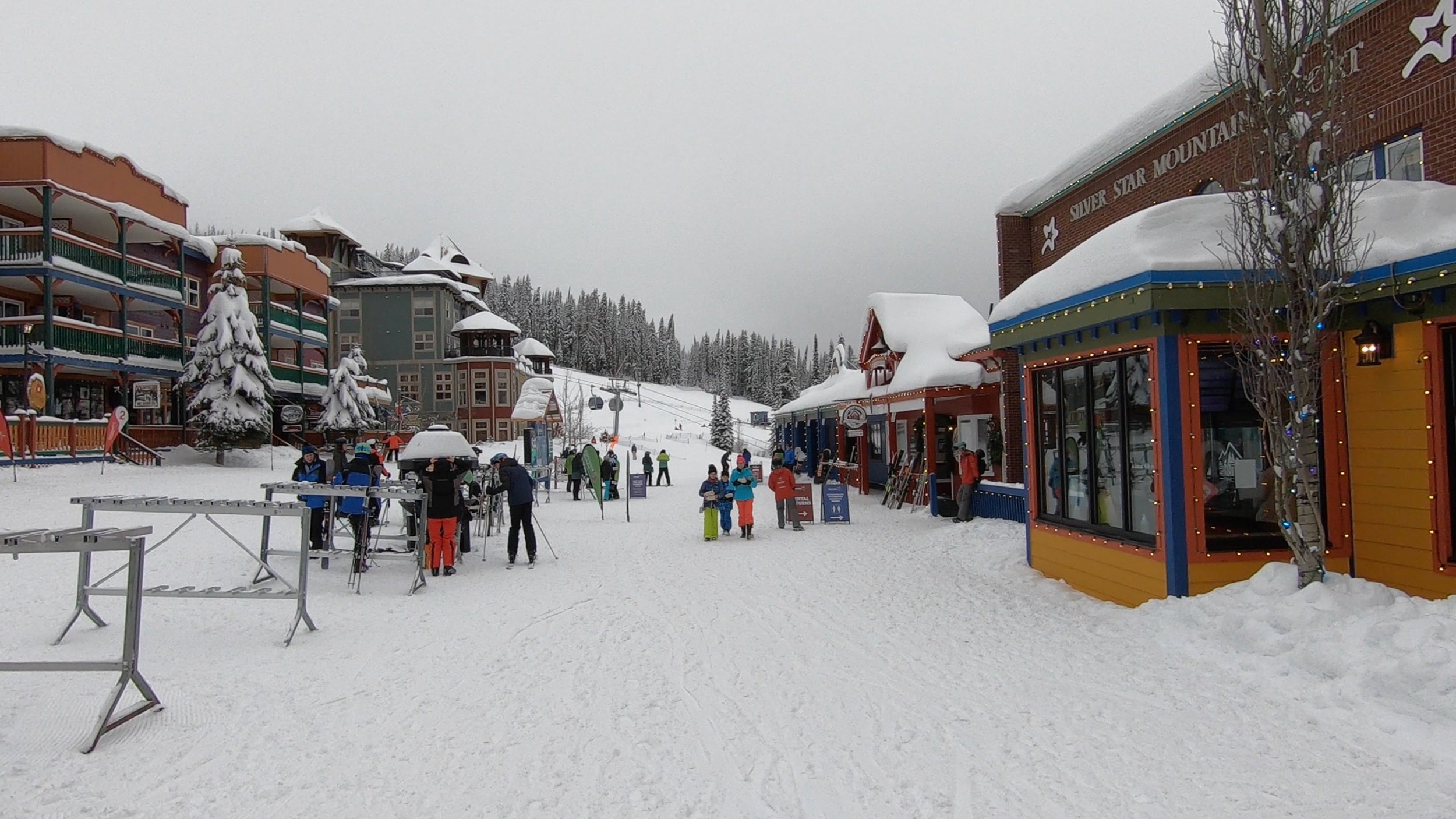Mountain Review: Lake Louise
MOUNTAIN SCORE
CATEGORY BREAKDOWN
See our criteria9
Snow:
9
Resiliency:
8
Size:
8
Terrain Diversity:
8
Challenge:
6
Lifts:
8
Crowd Flow:
4
Facilities:
5
Navigation:
10
Mountain Aesthetic:
GOOD TO KNOW
1-Day Ticket: $103-$115 USD ($139-$155 CAD)
Pass Affiliation: Ikon, Mountain Collective
On-site Lodging: No
Aprés-ski: Limited
Nearest Cities: Calgary (2 hrs)
Recommended Ability Level:
+ Pros
One-of-a-kind mountain aesthetic
Extraordinarily long season
Incredible advanced, expert, and freestyle terrain
Crowd management
Value
– Cons
Occasional extreme cold spells
Poorly-placed upper-mountain facilities
Slow lifts in some mountain zones
Arduous traverses in many areas
MOUNTAIN STATS
Lifts: 11
Trails: 164
Beginner: 10%
Intermediate: 16%
Advanced/Expert: 74%
RECENT ARTICLES
VIDEO
Mountain Review
Situated west of Banff town proper, Alberta’s Lake Louise is one of the preeminent destinations in Western Canada. This ski resort—which is actually a few miles from the iconic lake itself—may be remote, but it should be on the short list for a wide variety of destination-goers.
Mountain Aesthetic
Lake Louise is one of the most beautiful ski resorts in the world. The views of the surrounding mountains feel like those you’d see in movies; in fact, there isn’t a single place at the resort that doesn’t feel absolutely gorgeous. The lake itself is visible from many frontside areas, and it’s hard to find a more jaw-dropping aesthetic than this frozen body of water paired with the towering surrounding mountains.
Lake Louise is surrounded by some of the most beautiful mountains anywhere.
Snow Quality
And in most circumstances, Lake Louise boasts the snow to go with these views. The resort enjoys light, dry accumulation throughout the winter, and its season is one of the longest on the continent, extending from November to May. Lake Louise is one of the few resorts to be reliably fully open by Christmas each year.
Cold Spells
But Lake Louise’s incredibly consistent snow comes with a major catch—extraordinary cold spells. The resort is consistently well-below freezing throughout the core season, and temperatures dependably drop as low as -30°F a few times per year. Lower-mountain areas stay somewhat sheltered, but the bowls are highly wind-exposed and unbearable for any sane person during the coldest days. Guests should watch out for frostbite, which can set in within minutes, and come prepared with clothes to layer up and cover all bare skin. Occasionally, temperatures can get so low that the resort is forced to suspend operations entirely.
Lake Louise has consistent, high quality snow, but also sees windy upper mountain conditions and some of the coldest temperatures of any ski area.
On-Mountain Facilities
The effects of Lake Louise’s extreme temperatures are compounded by poorly placed facilities. Most upper-mountain areas are far away from lodges, meaning there’s no quick and convenient way to warm up in the resort’s most exposed areas. The only frontside mid-mountain lodge, the Whitehorn Bistro, is too low to provide an effective stopping ground; the chalet is below the loading zone for the Top of the World six-pack, meaning guests must go all the way down to the base after stopping there. The valley between the back side and Larch thankfully has a lodge, but it gets really busy during peak times, and guests will have to make sure to stay on the right trails to avoid missing it.
TRAIL MAP
Size and Terrain Layout
Measuring in at 3,000 acres, Lake Louise has the largest skiable footprint of the Banff SkiBig3 resorts. The resort features an extensive variety of terrain, including below-treeline slopes, near-treeline glades, and exposed high-alpine bowls. Lake Louise comprises three mountain zones: the front side, which offers a terrain mix for all abilities; the back side, which specializes in tougher high-alpine trails; and Larch, which mostly constitutes distinctive tree-defined and gladed runs.
Beginner Terrain
Lake Louise is good, but not great, for beginners. With the exception of the Summit chair, green runs can be found off every lift. But some of these runs—including all backside greens—are flat traverses, making them doable, but not necessarily enjoyable, for less experienced guests. In fact, the lower frontside greens are really the only ones that don’t require some catwalking or a short stint on a blue run to reach. Lake Louise’s base area currently has a small learning area, but it’s on track for expansion in the coming seasons.
Intermediate Terrain
Lake Louise is also solid but not class-leading for intermediates. The Larch zone is probably the best zone for intermediates, with a considerable variety of striking groomed cruisers—as well as the distinctive Rock Garden trail, which is littered with absolutely huge rocks. Frontside lifts also serve a handful of blue runs, including some breathtaking high-alpine runs off the Summit chair. However, intermediate offerings on the back side are limited.
Advanced and Expert Terrain
Guests will want to reach advanced proficiency to really appreciate Lake Louise. More than 70% of the resort’s terrain is rated black or double-black, and these runs earn their designation. Most are consistently ungroomed with tough pitches, although some of the below-treeline frontside blacks receive regular grooming. Even some single-blacks have obstacles such as cliffs. All double-blacks are extremely steep; some are comparable to double-blacks at other resorts while others have extreme technical features like cliffs. If you’re not familiar with the mountain and you don’t see tracks towards a certain trail, steer clear.
New to the Lake Louise expert footprint is the resort’s massive West Bowl expansion, which opened in 2020 and grew the resort by 20%. This tryingly long and steep area starts out as a wide-open bowl but filters into trees towards the bottom. While the West Bowl trails are all rated as single-black, some daunting rocks and cliffs are hidden about the footprint. Guests should beware that this area ends with a prolonged flat traverse.
Terrain Parks
Lake Louise has one of the best terrain park presences in Canada. Features vary considerably in size—with four frontside parks boasting features such as boxes, rails, jumps, and tubes—but the resort really stands out with huge 2XL jumps in the parks near the base.
RECOMMENDED SKIS FOR LAKE LOUISE
NOTE: We may receive a small affiliate commission if you click on the below links. All products listed below are unisex.
Recommended intermediate ski
Recommended advanced ski
Recommended glade ski
Recommended powder ski
Crowd Flow
Thanks in part to its remote location, Lake Louise doesn’t see the same crowds as popular Rockies destinations in the United States. But unlike an all-too-high proportion of its Canadian Rockies competitors, Lake Louise actually has a well-designed lift setup. Access to the resort comes through two key base lifts, the Glacier Express high-speed quad and Grizzly Express gondola, which distribute crowds well around the mountain. A third base lift—the Juniper Express—was added for the 2021-22 season, and a new upper Juniper lift for 2024-25 will add further uphill redundancy.
Lake Louise’s relatively manageable crowds and well-designed lift setup mean you’ll often spend less time waiting in lift lines than at many competitors.
Lifts
When it comes to the lifts themselves, Lake Louise offers a good setup overall. However, the resort could use some improvements.
The frontside and Larch lifts are modern and mostly high-speed, but both backside chairs—Ptarmigan and Paradise—are slow, fixed-grip lifts. While it’s technically possible to get back to the front side without taking a backside chairlift, the only trail back is an extraordinarily flat catwalk.
But there have been some improvements in recent years. The resort upgraded its Summit surface lift to a fixed-grip quad back in 2020. The new Summit Quad is in a completely different alignment than the old platter, and is much shorter—losing any redundancy with the Top of the World lift. It’s not as easy to lap certain lines anymore, but it’s now much more direct to reach the top of the mountain and overall a better setup. If you know what you’re doing, there are still a handful of expert chutes that are very easy to lap via the Summit lift.
Much of Lake Louise’s terrain requires tedious traversing to access or to exit.
Traverses
Lake Louise may be beautiful, but its traverses will almost always leave guests with a sour taste in their mouths.
In addition to the aforementioned West Bowl exit, traverses provide the primary means of backside and Larch access for beginner and intermediate visitors. These runs aren’t the worst in the world as far as flatness goes, but the perennially dry and slow snow makes for horrible speed retention. During typical core season days, skiers should expect a mini workout to complete these runs—and snowboarders should prepare to unstrap for lengthy walks out.
Getting There
Lake Louise is a 40-minute drive from the Banff city center, which itself is a 1.5 hour drive from the Calgary International Airport with no traffic. The resort runs free shuttle bus services to and from town, and there are several bus options available to town from the airport. Both Lake Louise and Banff proper are within Banff National Park, and it’s worth noting that those driving must purchase a park pass to drive to the resort.
The beautiful Fairmont Chateau Lake Louise is just a short drive from the resort.
Lodging
Lake Louise does not have any on-site lodging, but a few hotel accommodations—including the spectacular lakeside Fairmont Chateau Lake Louise—are just a short drive away from the resort. For those looking for more economical arrangements, the HI Lake Louise offers both shared and single rooms in a hostel setting.
A much more extensive array of lodging options exist in the town of Banff. Options in Banff can be found for any budget, ranging from economical shared-room hostels to even more ultra-luxury Fairmont hotels. For those looking for a bit better value from their accommodations, the town of Canmore sits an hour from Lake Louise and 20 minutes from Banff proper.
RECOMMENDED SNOWBOARDS FOR LAKE LOUISE
NOTE: We may receive a small affiliate commission if you click on the below links. All products listed below are unisex.
Recommended intermediate board
Recommended advanced board
Recommended expert board
Recommended powder board
Aprés-ski
After-slopes activities at Lake Louise are limited, and the hamlet of Lake Louise itself is so small that there’s very little to do—besides visiting the lake itself. A handful of restaurants exist in the hamlet, but they aren’t sufficient for the demand and reservations must be made far in advance.
Options become much more substantial in the town of Banff itself, with several bars, restaurants, and activities to keep guests entertained. The venues are close to one another, making it easy to bar hop.
The beautiful town of Banff has plenty of bars, restaurants, and activities to occupy guests after a day on the slopes.
Verdict
Lake Louise’s unparalleled natural beauty, top-tier consistency, and onerous expert terrain make it a great choice for a destination trip—especially one earlier in the season. The resort doesn’t have the largest beginner or intermediate footprint—and cold spells are always a risk—but the surroundings are so striking that just about everyone will come out impressed.
Pricing
Compared to U.S. competitors, Lake Louise’s lift tickets are a bargain, topping out at just $155 CAD ($115 USD). With high quality slopes for all visitors, especially advanced and expert skiers and snowboarders, it is hard to find a better value.

































A comprehensive overview of the most beautiful ski resorts in North America, and why they stand out so much.